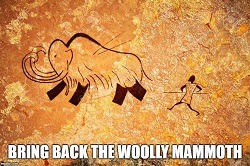

 The Accurate Reloading Forums
The Accurate Reloading Forums  THE ACCURATE RELOADING.COM FORUMS
THE ACCURATE RELOADING.COM FORUMS  Hunting
Hunting  African Big Game Hunting
African Big Game Hunting  Mim's Historical Find
Mim's Historical FindGo  | New  | Find  | Notify  | Tools  | Reply  |  |
| One of Us |
This is from Mims Reed and I will let him tell you the story!  ~Ann  | ||
|
| one of us |
This was sent to me by a friend in RSA. During the stage coach days, horse sickness was always a problem in the low altitude regions. For a while it was thought that zebras might make a suitable alternative to horses and mules, and that they would have better disease resistance and be more effective at staying out of reach of lions. they met all thses criteria, but they lacked stamina. The also posessed and uneven temperatement. When they became tired, the would simply lie down and refuse to budge. Attempts to move them would be met with kicking and biting. Harry Zeederberg, owner of the once famous Zeederberg coach lines, finally abandoned the project after a few trial runs that drew much public attention. Thanks Ann for posting the photo. You can borrow money but you can not borrow time. Go hunting with your family. | |||
|
one of us |
From Peter Beard's book "The End Of The Game", Dr. Rosendo Ribeiro making rounds in early Nairobi:  NRA Life Member, Band of Bubbas Charter Member, PGCA, DRSS. Shoot & hunt with vintage classics. | |||
|
| one of us |
| |||
|
One of Us |
They shouldn't have used the FEMALES !!!! | |||
|
| One of Us |
Cool photos! There is a movie in the theaters here called "Racing Stripes" and it's about a young girl entering her zebra in horse races (and winning). Now my 10 year old daughter wants us to get some land and raise zebras for horse racing. Speaking of zebra - I want to upholster a chair in zebra skin. Anyone know where to pick some up inexpensively? I've seen them on ebay from $600 and up.  | |||
|
| one of us |
Ann, In the latter half of the 19th century zebras and quaggas (an extinct animal with the stripes of a zebra on the front half of it's body and the rear coloured in a plain shade like a donkey) were used to draw fashionable carriages in London. This is a lovely picture. Thanks for posting it. Mehul Kamdar "I ask, sir, what is the militia? It is the whole people. To disarm the people is the best and most effectual way to enslave them."-- Patrick Henry | |||
|
| One of Us |
Right John, they should have used GELDINGS. ~Ann  | |||
|
| one of us |
I have ridden both camels and a Zebra in Rodeos as an exhibition...A funny story about Zebras: In my mispent cowboy youth while rodeoing professionally I was in the horse barn in El Paso, Texas looking at the Zebra that I had rode the night before at a trot in the arena and the owner was there....I asked him if they could buck because from sitting on top of him I was amazed at how damn wide his neck and shoulders were for such a small animal...He said no one on earth could ride a zebra if the zebra didn't want to be ridden, I told him thats a might big statement around this group..He said would you like to try for a hundred dollar bill towit I said I rode him last night, and he said yes, but that was in an arena, thats the only place you can ride him, If you ride him two jumps I will give you $200 and if you don't you give me $100...I told this turkey that he was on because I could ride anything two jumps and then saftied up and said can I hold the saddle horn, he said I don't care what you do, now I'm getting nervous this is sounding funny already but what the hell, he saddled old stripes and said get on.. I grabbed the bridle and pulled his head around to the horn and quickly stepped on...He never moved a muscle and I'm all smiles, then this guy says to me, are you ready, and I got all scrouched down in the saddle and he simply tossed his hat under the Zebra, thats the last thing I remember...Apparantly he bolted and I mean bolted sideways and my head hit the ground first and my imprint in the sand was exactly dead center betwee his four foot prints..The fellows with me said they had never seen a move like that, it was like somelone flushed the toilet and down I went, hard...the owner walked off with my $100 and said he made about a $1000 per week on the Zebra with cowboys around the rodeo...the word got out pretty soon but there were those who just had to try, nobody ever got it done as far as I know, and I had no desire to ever consider it again, I just stuck with bucking horses after that.... Ray Atkinson Atkinson Hunting Adventures 10 Ward Lane, Filer, Idaho, 83328 208-731-4120 rayatkinsonhunting@gmail.com | |||
|
| one of us |
LMAO...I think we have all learned a lesson like that at one time or another...but that was funny Ray. I guess a fella should Cowboy Up on what he really knows and not what he thinks he knows. You can borrow money but you can not borrow time. Go hunting with your family. | |||
|
one of us |
Ray I'm just glad that the story didn't include a dog,womens clothes,whiskey and paternity suits. | |||
|
| one of us |
Recent genetic analysis of quagga hides demonstrated that rather than a species of its own, the quagga was a color variant of the Burcell's zebra. I looked into this and it appears that a couple of game breeders in RSA are breeding zebras back to restablish the quagga. I think I saw a picture of one that was almost completely successful. It shouldn't take more than a few more years to finalize. The first trophy fees will likely be whoppers, though. Sarge Holland's .375: One Planet, One Rifle . . . for one hundred years! | |||
|
| One of Us |
Some excerpts from Jared Diamond's excellent book, "Guns, Germs, and Steel": "In the 19th and 20th centuries at least six large mammals--the eland, elk, moose, musk ox, zebra, and American bison--have been the subjects of especially well-organized projects aimed at domestication, carried out by modern scientific animal breeders and geneticists. For example, eland, the largest African antelope, have been undergoing selection for meat quality and milk quantity in the Askiniya-Nova Zoological Park in the Ukraine, as well as in England, Kenya, Zimbabwe, and South Africa; an experimental farm for elk (red deer, in British terminology) has been operated by the Rowett Research Institute at Aberdeen Scotland; and an experimental farm for moose has operated in the Pechero-Ilych National Park in Russia. Yet these modern efforts have achieved only very limited successes. . . . [N]one of these efforts has yielded a result of sufficient economic value to attract many ranchers. . . . In all of the world's 148 big wild terrestrial herbivorous mammals--the candidates for domestication--only 14 passed the test [sheep, goats, pigs, cows, horses, donkeys, water buffalo, llamas/alpacas, Bactrian camels, Arabian camels, reindeer, yak, gaur and banteng]. . . . [All other species have been] 'destined to perpetual wildness'." Why? Diamond posits six factors: 1. Diet. Efficiency of conversion of consumed biomass to the consumer's biomass. 2. Growth Rate. 3. Problems of Captive Breeding. Like humans (other than porn stars), some critters just don't like to have sex under the watchful eyes of others. 4. Nasty Disposition. Lots of examples, including cape buffalo and zebras: "Efforts at domestication [of zebras] went so far as hitching them to carts: they were tried out as draft animals in 19th-century South Africa, and the eccentric Lord Walter Rothschild drove through the streets of London in a carriage pulled by zebras. Alas, zebras become impossibly dangerous as they grow older. . . . Zebras have the unpleasant habit of biting a person and not letting go. They thereby injure even more American zoo-keepers each year than do tigers! Zebras are also virtually impossible to lasso with a rope--even for cowboys who win rodeo championships by lassoing horses--because of their unfailing ability to watch the rope noose fly toward them and then to duck their head out of the way." 5. Tendency to Panic. Think, gazelles and wildebeest. 6. Social Structure. For domestication, animals need to live in large herds (as opposed to ranging singly or in small groups), have a dominance hierarchy (that a human can take over) and live in overlapping ranges (rather than mutually exclusive territories). So this factor alone rules out vast numbers of species as candidates for domestication. Interesting, eh? I should add that of all the animals I have killed in Africa, only a zebra ever charged me with intent to do bodily harm. Mike Wilderness is my cathedral, and hunting is my prayer. | |||
|
| Powered by Social Strata |
| Please Wait. Your request is being processed... |
|

Visit our on-line store for AR Memorabilia

